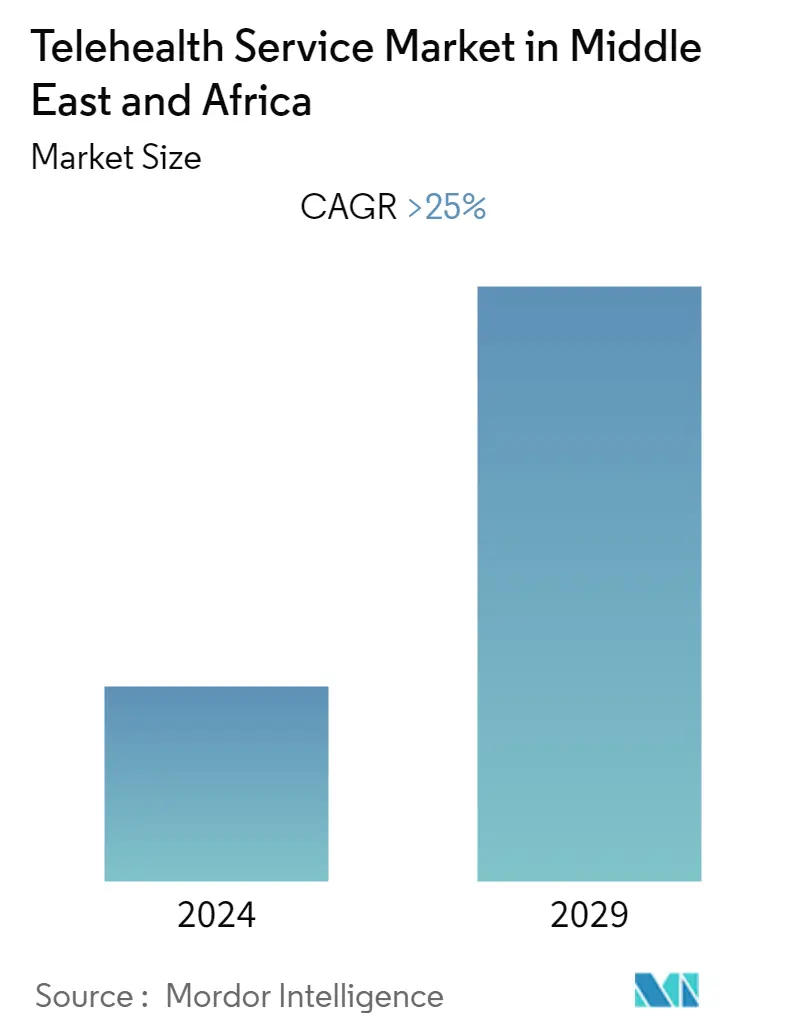Market Size of Telehealth Service Industry in Middle East and Africa

| Study Period | 2020 - 2029 |
| Base Year For Estimation | 2023 |
| CAGR | > 25.00 % |
| Fastest Growing Market | Asia-Pacific |
| Largest Market | North America |
| Market Concentration | Medium |
Major Players
*Disclaimer: Major Players sorted in no particular order |
MEA Telehealth Service Market Analysis
Telecommunication technology paved the way for a revolution in the healthcare sector with smartphones, computers, and the internet. Telehealth can be defined as the remote delivery of clinical as well as non-clinical services through telecommunication and digital communication technologies. It is also used by medical practitioners for various telemedicine services (consultation, mentoring, and monitoring), for the training of medical staff, for administrative meetings, and for imparting medical education.
The Middle East Telehealth Market is expected to register significant growth in the coming timeframe on the back of the virtual healthcare platform. The platform on the digital economy is benefitting the healthcare sector to leverage technology for enhanced agility in the face of environmental disruptions and to create innovative business orientation models for a new normal, purpose-driven, inclusive, and sustainable future growth in the foreseeable timeframe.
Covid-19 has had a positive impact on the telehealth industry in the Middle East and Africa. The awareness of telehealth has increased rapidly during Covid-19 because of lockdowns and isolations and people have started adapting to it to avoid the virus contamination which has resulted in high demand in this market.
In terms of its healthcare system, the Middle East was already 'on a transformational journey' even before the COVID-19 pandemic, with a more recently amped-up timeline. Although telehealth is currently a small sector within the overall healthcare market, it is one of the fastest-growing, recently aided by healthcare reforms. Experts predict that virtual healthcare will become the new normal in the Middle East, even after COVID-19 slows down.
MEA Telehealth Service Industry Segmentation
The rise in the number of chronic diseases has caused an extra financial burden on the healthcare sector. Telehealth is making a way to provide care, monitor patients, and transmit any health-related information by using the latest telecommunication technologies in the Middle East and Africa. Monitoring these diseases allows an early-stage identification of the diseases which in turn will help prevent these chronic disease conditions. Telehealth systems can be used to track and support patients with chronic conditions that can be treated without the need for hospital visits.
The Middle East Telehealth Market report thoroughly covers the market By Component (Products and Services), By Delivery Mode (Cloud-Based Delivery Mode, Web-Based Delivery Mode, and On-Premise Delivery Mode), By Application (General Consultation, Pathology, Cardiology, Gynecology, Neurology, Radiology, Dermatology, and Ophthalmology), By Type (Tele Hospital, Telehomes, and health), and By End Users (Healthcare Providers, Payers, and Healthcare Consumers). In addition to a detailed study presenting the impact of political and economic aspects governing the market, digital innovations reshaping the sector in the country are presented in the report. The scope of the market is comprehensive and is limited to the Middle East and Africa.
| By Component | ||||||
| ||||||
|
| By Delivery Mode | |
| Cloud-Based Delivery Mode | |
| Web-Based Delivery Mode | |
| On-Premise Delivery Mode |
| By Application | |
| General Consultation | |
| Pathology | |
| Cardiology | |
| Gynecology | |
| Neurology | |
| Radiology | |
| Dermatology | |
| Ophthalmology |
| By Type | |
| Tele Hospital | |
| Telehomes | |
| mhealth(Mobile Health) |
| By End Users | |
| Healthcare Providers | |
| Payers | |
| Healthcare Consumers |
Telehealth Service Market in Middle East and Africa Size Summary
The telehealth service market in the Middle East and Africa is experiencing a transformative phase, driven by advancements in telecommunication technologies such as smartphones, computers, and the internet. Telehealth, encompassing both clinical and non-clinical services delivered remotely, has gained significant traction, particularly during the COVID-19 pandemic. The pandemic accelerated the adoption of telehealth solutions as lockdowns and social distancing measures prompted a shift towards virtual healthcare to minimize virus transmission. This shift is expected to continue, with telehealth becoming an integral part of the healthcare landscape in the region, supported by ongoing healthcare reforms and the digital economy's expansion. The market, though currently a small segment within the broader healthcare industry, is one of the fastest-growing sectors, with experts forecasting its continued expansion as virtual healthcare becomes the new norm.
The mobile health (mHealth) segment is poised for substantial growth, driven by the increasing demand for quality healthcare services and the widespread adoption of mobile technologies. mHealth aims to empower patients through enhanced decision-making and improved health outcomes, contributing to cost reduction and increased access to healthcare services. The healthcare consumer segment, particularly in telemedicine, dominates the market as patients seek convenient solutions for various health issues. The market is moderately consolidated, with key players like Honeywell Life Care Solutions, Medtronic Inc., and others expanding their presence and innovating through new technologies. The demand for telehealth services is further bolstered by government initiatives promoting e-health and the rising need for home-based healthcare solutions, a trend that has been amplified by the pandemic.
Telehealth Service Market in Middle East and Africa Market Size - Table of Contents
-
1. MARKET DYNAMICS AND INSIGHTS
-
1.1 Market Overview
-
1.2 Market Drivers
-
1.3 Market Restraints
-
1.4 Insights on Various Regulatory Trends Shaping Telehealth Services Market in Middle East and Africa
-
1.5 Insights on Impact of Technology and innovation in Telehealth Services
-
1.6 Insights on Performance of Telehealth Services in Middle East and Africa
-
1.7 Industry Attractiveness - Porters' Five Forces Analysis
-
1.7.1 Threat of New Entrants
-
1.7.2 Bargaining Power of Buyers
-
1.7.3 Bargaining Power of Suppliers
-
1.7.4 Threat of Substitutes
-
1.7.5 Intensity of Competitive Rivalry
-
-
1.8 Impact of COVID-19 on the Market
-
-
2. MARKET SEGMENTATION
-
2.1 By Component
-
2.1.1 Product
-
2.1.1.1 Software
-
2.1.1.2 Hardware
-
-
2.1.2 Services
-
2.1.2.1 Teleradiology
-
2.1.2.2 Telecardiology
-
2.1.2.3 Teledermatology
-
2.1.2.4 Other services
-
-
-
2.2 By Delivery Mode
-
2.2.1 Cloud-Based Delivery Mode
-
2.2.2 Web-Based Delivery Mode
-
2.2.3 On-Premise Delivery Mode
-
-
2.3 By Application
-
2.3.1 General Consultation
-
2.3.2 Pathology
-
2.3.3 Cardiology
-
2.3.4 Gynecology
-
2.3.5 Neurology
-
2.3.6 Radiology
-
2.3.7 Dermatology
-
2.3.8 Ophthalmology
-
-
2.4 By Type
-
2.4.1 Tele Hospital
-
2.4.2 Telehomes
-
2.4.3 mhealth(Mobile Health)
-
-
2.5 By End Users
-
2.5.1 Healthcare Providers
-
2.5.2 Payers
-
2.5.3 Healthcare Consumers
-
-
Telehealth Service Market in Middle East and Africa Market Size FAQs
What is the current Middle East and Africa Telehealth Service Market size?
The Middle East and Africa Telehealth Service Market is projected to register a CAGR of greater than 25% during the forecast period (2024-2029)
Who are the key players in Middle East and Africa Telehealth Service Market?
Honeywell life Care Solution, Medtronic Inc, AMD telemedicines Inc., Lifewatch and Aerotel Medical Systems Ltd. are the major companies operating in the Middle East and Africa Telehealth Service Market.

